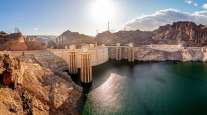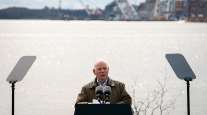Trump to Release Infrastructure Plan in January, Official Says

President Donald Trump plans to keep pushing his legislative agenda in 2018 by releasing his long-promised infrastructure proposal in early January, a senior administration official said.
Infrastructure advocates question whether a Republican-led Congress will be able to pass a spending plan with enough federal funding if it’s already approved a tax measure that official estimates say would bloat the budget deficit. Some say the administration missed its best opportunity to deliver a meaningful public works initiative by not incorporating it into the tax bill, which is nearing approval.
RELATED: Infrastructure funding talks expected to gain momentum after tax reform concludes
RELATED: Illinois budget puts state roads in crisis, advocates say
“If they’d taken up infrastructure, we’d have a bill today and have the money to fund it,” said Ray LaHood, a Republican and former transportation secretary under President Barack Obama. “Nothing happened this year, so the prospects of anything happening next year I think are pretty slim,” said LaHood, who is a co-chairman of Building America’s Future, a bipartisan coalition that promotes infrastructure.
The Russell 3000 Building Materials Index gained as much as 2.2% on the news and closed up 1.8%, as companies including Summit Materials Inc., Vulcan Materials Co. and Martin Marietta Inc. spiked sharply higher.
Trump Promised
Trump promised during his campaign to introduce a $1 trillion proposal within his first 100 days in office, then the administration said there’d be a plan by the third quarter. That didn’t happen after the failed attempt to overhaul health care and the ongoing tax effort.
The president aims to release a detailed document of principles, rather than a drafted bill, for upgrading roads, bridges, airports and other public works before the Jan. 30 State of the Union address, said the administration official, who spoke on condition of anonymity because the details aren’t public. Naysayers should wait until they see the details and how the legislative process unfolds, the official said.
RELATED: Caucus created to keep focus on infrastructure investment
The White House plan is essentially complete and Trump recently reviewed it, the official said. It calls for allocating at least $200 billion in federal funds over 10 years to spur at least $800 billion in spending by states, localities and the private sector.
The plan would put the federal dollars in four areas: cash for states and localities, with preference for entities that generate their own funding as well; formula block grants for rural areas; federal lending programs; and money for “transformational” work such as plans to build high-speed trains in tunnels by Boring Co., which was founded by Elon Musk.
Shift Responsibility
The guiding principle of the plan is to shift responsibility for funding from the federal government to states and localities — which own or control most assets — by providing incentives for them to generate their own sustainable funding sources and work with the private sector.
Still, some governors and mayors have already balked, saying they’re doing their fair share and that much more federal funding is needed to meet what the American Society of Civil Engineers has estimated to be a $2 trillion funding gap for infrastructure by 2025. Some advocates say the best chance was to include measures such as a higher gas tax or levies on corporate profits returned from overseas in the tax overhaul.
“We need to be honest with the American people: failure to find the revenue for an infrastructure initiative now, as part of tax reform, will make passage of such a package nearly impossible in the future,” Bud Wright, executive director of the American Association of State Highway and Transportation Officials, said in a letter last month to Senate leaders.
Too Difficult
The White House official said it would have been too difficult to combine infrastructure with the tax bill. The plan now is to give Congress a blueprint for a bill and allow the details — including funding — to be negotiated in a bipartisan way, the official said.
The U.S. Chamber of Commerce sees the $200 billion amount as “a floor, not the ceiling,” said Ed Mortimer, the chamber’s executive director for transportation infrastructure.
“While we’re all for leveraging limited federal dollars, the federal government can start by increasing its own investment,” Mortimer said.
The chamber has advocated raising the federal gas tax, which hasn’t been increased since 1993 as the easiest and fairest way to generate money. The administration hasn’t endorsed the idea but hasn’t taken it off the table, either.
‘Cautiously Optimistic’
Michael Burke, chairman and chief executive of AECOM, the world’s biggest engineering firm, said he’s “cautiously optimistic” about Congress enacting an infrastructure bill in 2018 but is disappointed that it didn’t happen this year.
“No doubt in my mind, it is a missed opportunity,” Burke said.
Despite the “headwinds and political turmoil,” Macquarie Infrastructure and Real Assets remains hopeful a proposal will emerge in 2018 because there is political constituency for it from across the political spectrum, Managing Director David Agnew said in a statement.
Incentives in the plan “would unlock hundreds of billions of dollars of state, local, and private capital,” Agnew said.
One problem is how to treat states and localities that have already raised money for projects so they’re not disadvantaged in the competition for federal funding, said Jim Tymon, chief operating officer of the American Association of State Highway and Transportation Officials in Washington.
Gas Taxes
Twenty-six states have raised or adjusted their motor-fuel tax rates and other fees during the past five years, and voters in 20 states approved $4.2 billion in new and continued funding for infrastructure in Nov. 7 ballot issues alone, according to the American Road & Transportation Builders Association.
The White House official said entities that raised revenues over time would get credit in the process, as will those that take action in 2018 instead of waiting for a federal bill.
The Trump administration has also said a major element of its plan will be streamlining environmental reviews and permitting for projects, vowing to reduce the time it takes to get approvals to about two years.
But there have been previous streamlining initiatives that have not yet been implemented, and it would be a mistake to focus on streamlining when more funding is needed, said Peter DeFazio of Oregon, the top Democrat on the House Transportation and Infrastructure Committee. He said the initiative is already at risk because it has been delayed so long.
Still, infrastructure has always been a bipartisan issue, and there has not been this type of discussion about infrastructure at the federal level in decades, said Dave Bauer of the American Road & Transportation Builders Association.
“We’ll have a much better sense of the potential when we see how Congress responds to what the administration puts forward,” he said.
With assistance by Esha Dey




